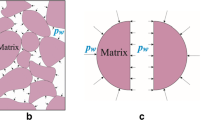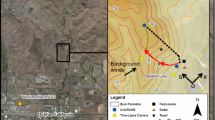Abstract
Frost injury patterns are commonly observed on the warm-season turfgrass species bermudagrass (Cynodon species Rich.), zoysiagrass (Zoysia species Willd.), and buffalograss [Bouteloua dactyloides (Nutt.) J.T. Columbus] in cool-temperate and subtropical zones. Qualitative observations of these injury patterns are presented and discussed. A model for the formation of such patterns based on thermal instability and convection of air is presented. The characteristic length scale of the observed frost pattern injury requires a temperature profile that decreases with height from the soil to the turfgrass canopy surface followed by an increase in temperature with height above the turfgrass canopy. This is justified by extending the earth temperature theory to include a turf layer with atmosphere above it. Then the theory for a thermally unstable layer beneath a stable region by Ogura and Kondo is adapted to a turf layer to include different parameter values for pure air, as well as for turf, which is treated as a porous medium. The earlier porous medium model of Thompson and Daniels proposed to explain frost injury patterns is modified to give reasonable agreement with observed patterns.












Similar content being viewed by others
Abbreviations
- A :
-
Temperature amplitude
- a :
-
Dimensionless wave number
- b :
-
Wave number
- α :
-
Thermal expansion coefficient
- c :
-
Specific heat at constant pressure
- Da:
-
Darcy number
- ΔT :
-
Temperature difference
- δT :
-
Deviation from the average temperature
- g :
-
Acceleration of gravity
- γ :
-
Ratio of stable to unstable temperature gradients
- h :
-
Sample height
- k :
-
Permeability
- κ :
-
Thermal diffusion coefficient
- L :
-
Turf height
- λ :
-
Pattern wavelength
- μ :
-
Shear viscosity
- ν :
-
Kinematic viscosity
- ω :
-
Angular frequency
- p :
-
Pressure
- Pr:
-
Prandtl number
- Q :
-
Radiative heat flux absorbed
- ϕ :
-
Phase
- Ra:
-
Rayleigh number
- ρ :
-
Density
- T :
-
Temperature
- t :
-
Time
- u :
-
Velocity
- z :
-
Vertical spatial dimension
References
Ahlers G (2006) Experiments with Rayleigh–Bernard convection. In: Mutabazi I, Wesfreid JE, Guyon E (eds) Dynamics of spatio-temporal cellular structures. Springer tracts in modern physics. Vol. 207. Springer Publishing, New York, pp 67–94. doi:10.1007/978-0-387-25111-0_4
Atwell B, Kriedemann P, Turner C (1999) Plants in action. Vol. 1. McMillan Education Australia, South Yarra
Bajaj KMS, Mukolobwiez N, Currier N, Ahlers G (1999) Wave number selection and large-scale-flow effects due to a radial ramp of the spacing in Rayleigh–Bénard convection. Phys Rev Lett 83:5282
Busse FH, Clever RM (1991) Transitions to complex flows in thermal convection. Arch Mech 43:565–575
Cook DR (1990) Predicting frost at your house. J Meteorol 15(153)
de Vries DA (1963) Thermal properties of soils. In: van Wijk WR (ed) Physics of plant environment. North-Holland Publishing Company, Amsterdam, pp 210–235
Engineering Toolbox (2012) Engineering Toolbox. Air properties. http://www.engineeringtoolbox.com/air-properties-d_156.html. Accessed 28 Nov 2012
Farouki OT (1986) Thermal properties of soils. Series on rock and soil mechanics. Vol. 11. Trans Tech Publ, Clausthal-Zellerfeld
Getling AV (1998) Rayleigh–Benard convection. World scientific Pub. Co. Printed in Singapore, Singapore. US Distribution office, River Edge
Gierer A (1981) Generation of biological patterns and form. Prog Biophys Mol Biol 37:1–47
Hillel D (1982) Introduction to soil physics. Academic, San Diego
Jackson GW, James DF (1986) The permeability of fibrous porous media. Can J Chem Eng 64:364–374
Krishnamurti R (1973) Some further studies on the transition to turbulent convection. J Fluid Mech 60:285–303
Landau LD, Lifshitz EM (1959) Fluid mechanics. Pergamon Press, London, pp 212–217
Marcellos H (1977) Wheat frost injury–freezing stress and photosynthesis. Aust J Agric Res 28:557–564
Marcellos H, Single WV (1975) Temperatures in wheat during radiation frost. Aust J Exp Agric Anim Hus 15:818–822
Martin M, Berdahl P (1984) Characteristics of infrared sky radiation in the United States. Sol Energy 33:321–336
Merriam-Webster, Inc (1986) In: Gove PB (ed) Webster’s third new international dictionary. Mirriam-Webster, Inc, Springfield, p 915
Meyer CW, Ahlers A, Cannell DS (1991) Stochastic influences on pattern formation in Rayleigh–Benard convection: ramping experiments. Phys Rev A44(4):2514–2537
Nield DA, Bejan A (1999) Convection in porous media. Equation (6.14a). Springer Publishing, New York, p 191
Ogura Y, Kondo H (1970) A linear stability of convective motion in a thermally unstable layer below a stable region. J Meteorol Soc Jpn 48(3):204–215
Patton A, Richardson M (2007) Economic impact of April frost on turfgrass species. Univ of AR Turf Tips. Issue May 11, 2007. http://turf.uark.edu/turfhelp/archives/051107.html. Accessed 28 Nov 2012
Phalippou J, Woignier T, Sempere R, Dieudonne P (2002) Highly porous aerogels of very low permeability. Mater Sci 20(1):29–42
Rietkerk M, van de Koppel J (2008) Regular pattern formation in real ecosystems. Trends Ecol Evol 23(3):169–175
Single WV (1964) Studies on frost injury to wheat: ice formation within the plant. Aust J Agric Res 15:869–875
Sutherland RA (1986) Broadband and spectral emissivities (2–18 μm) of some natural soils and vegetation. J Atmos Ocean Technol 3:199–202
Thiery JM, D’Herbes JM, Valentin C (1995) A model simulating the genesis of banded vegetation patterns in Niger. J Ecol 83:497–507
Thompson SE, Daniels KE (2010) A porous convection model for grass patterns. Am Nat 175(1):E10–E15
Weather Warehouse (2006) Weather Warehouse. Stillwater Regional Airport Weather Station. http://weather-warehouse.com/. Accessed 5 April 2012
Acknowledgments
The authors acknowledge discussions with Dr. Greg Bell, Professor Emeritus of Turfgrass Management/Science Program in the Department of Horticulture and Landscape Architecture, Oklahoma State University, Stillwater, OK, and with Karen Daniels, Department of Physics, North Carolina State University, Raleigh, NC.
Author information
Authors and Affiliations
Corresponding author
Rights and permissions
About this article
Cite this article
Ackerson, B.J., Beier, R.A. & Martin, D.L. Ground level air convection produces frost damage patterns in turfgrass. Int J Biometeorol 59, 1655–1665 (2015). https://doi.org/10.1007/s00484-015-0972-3
Received:
Revised:
Accepted:
Published:
Issue Date:
DOI: https://doi.org/10.1007/s00484-015-0972-3




